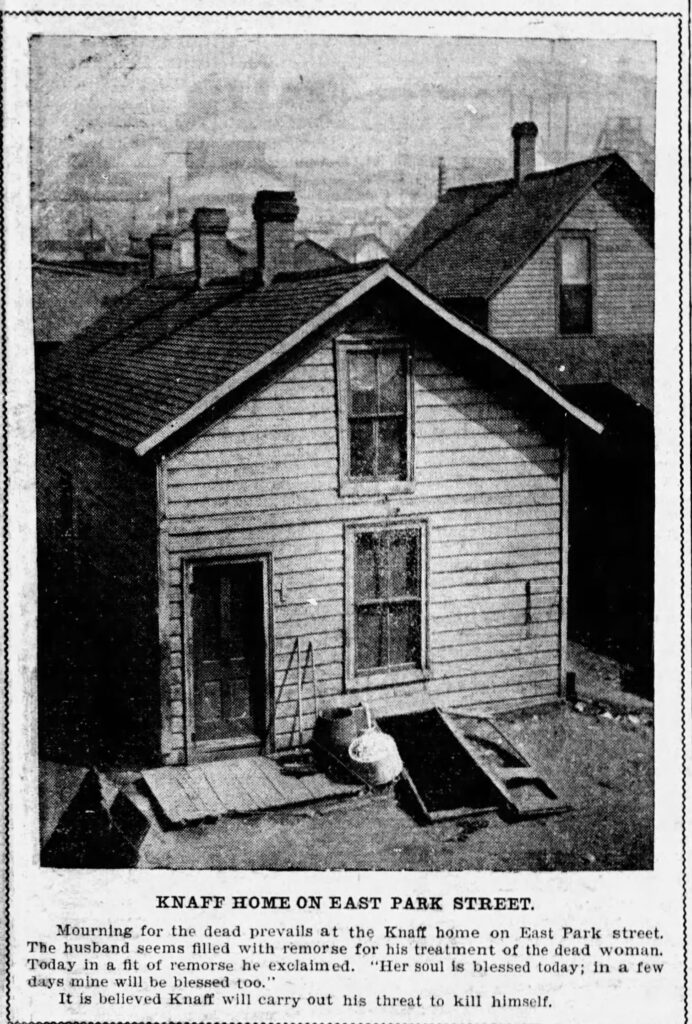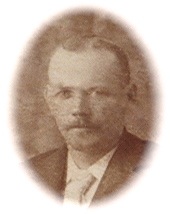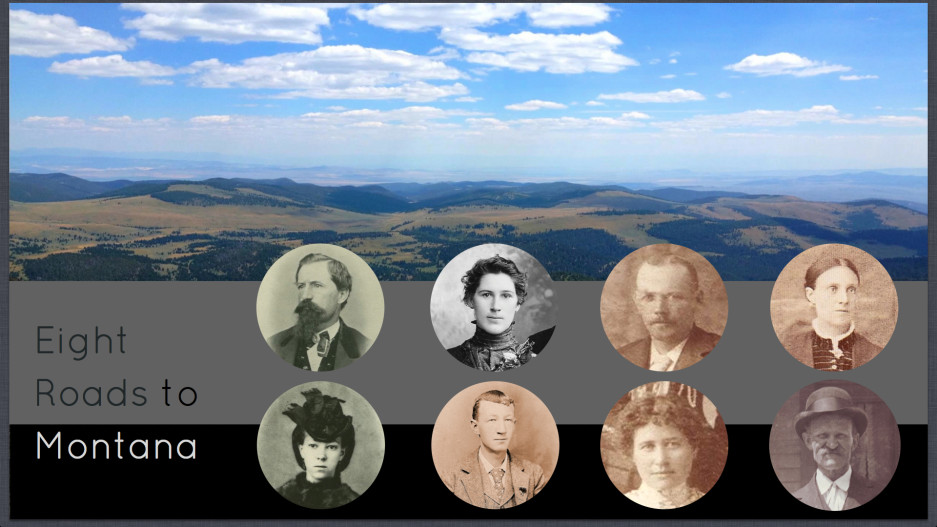This is a true story about an event in the life of my great grandfather Joseph Kieran in 1902, offered here in the writing style known as “creative nonfiction”.
————
“Come quick!”, the young boy said. Your cousin . . . your cousin Mary! She’s dying!!
As he hurried out the door, following the messenger headed down the hill on North Wyoming street, Joseph was perhaps only a little surprised to hear the disturbing news. Mary had paid him a visit just a few weeks prior to talk about how despondent she’d been feeling. He was very concerned for her even then but knew there was very little he could do to help.
Feeling a keen sense of urgency, he began to pick up his pace for the often-travelled 15-minute walk to his cousin’s house.
When he finally arrived late that Sunday afternoon, there were several people at the house. Mary’s husband John, Dr. Sullivan, Lilly Finley (a former boarder that Joseph knew), and a few other women he didn’t recognize. And Mary, of course, who was lying on the sofa in a terrible state . . . just barely alive.

Dr. Sullivan explained that he was summoned earlier by Father Calahan to Mary’s home where he learned that Mary had ingested carbolic acid at around 3 o’clock that afternoon. Dr. Sullivan immediately made his way to her house, stopping at a drugstore to pick up some antidotes. But there was not much he could do by the time he arrived that would afford any hope.
The mood in the room was somber.
Overcome by his emotions, Joseph immediately confronted Mary’s husband John, crying out, “Well, you are satisfied now, are you? “You have driven her to kill herself!”
Another doctor arrived about an hour later and, after consulting with Dr. Sullivan, agreed there wasn’t much that could be done.
Joseph slowly dropped into a chair near his cousin, and began to recall the details from their last visit together.
He knew Mary had been forced to take in boarders in order to support herself and her husband. He also recalled Mary telling him that John had only worked about three weeks since the prior December; and that he was recently coming home late at night, eventually arriving drunk; and sometimes would even be gone for several days at a time.
And then there was the story about a man who showed up at their home and threatened to shoot John if he didn’t stop seeing his wife.
Mary also told Joseph that she often wished she was dead because her life had become so miserable.
Joseph suggested that she bring her things and come and stay at his house. He and his wife Kate operated a boarding house and they could surely make room for her. But after much discussion and urging on his part, Mary reluctantly declined his kind offer, saying she didn’t want to break up her marriage.
As Joseph realized that his cousin’s marital problems were even more serious than he had realized, his thoughts of that last visit were bluntly interrupted when he heard John emotionally beg for a revolver so that he could shoot himself. One of the women in the house offered to get him one. Joseph didn’t think he had any intention of using it. He thought John was “running a bluff”.
Mary died that evening. Sunday, April 28, 1902 at 7 pm.
An inquest was held the next day at the undertaking rooms of the Montana Undertaking Company in Butte, Montana.
John Boyle, a friend of the couple who was present in the house about an hour before Mary drank the carbolic acid, testified that he’d known the couple for five years. He was only at the house for about 15 minutes and didn’t hear or see anything unusual.
Mrs. James Flynn, a former neighbor, testified that Mary told her about the woman whose husband had threatened John. She also testified that Mary often shared with her that she was displeased and at times and wished she was dead because she had a miserable life.
Miss Lilly Finley testified that she was at the house with Mary in the morning, and until John came home at about 2 o’clock that day. John left the house at about 8 o’clock a.m., before she arrived.
Miss Finley also described an incident that occurred early in the afternoon where John was hiding two dollars from Mary. She wanted one dollar and he wouldn’t give it to her. Sometime afterwards Mary went into the front room, came back out and told John and Lilly to “go for a doctor” and her cousin because she was dying.
Lilly went next door to tell Mrs. Irvine, the neighbor. Mrs. Irvine went for Father Calahan and her husband went for the doctor. Lilly also testified that she found a “regular beer glass” that seemed to have been about two-thirds full of carbolic acid, with only a sign of it left.
Several of the witnesses, including Lilly Finley and Mrs. James Flynn, agreed that Mary Knaff committed suicide due to her despondency over the situation with her husband. They all reported that she had been “wasting away” over the last few months.
Dr. Sullivan testified that Mary had burns on her face when he arrived, as well as the odor of carbolic acid on her breath. Her pupils were characteristic of carbolic acid poison, which “is about the same as opium poison . . . but she had gone beyond that, she was about dying.” Dr. Sullivan tried to administer some whiskey, which he stated was the best antidote but her throat was paralyzed. He also gave her a hyperdermic injection of strychnine to “keep the heart up”, but it was too late to save her.
Mary’s husband John testified that the couple “never had any trouble whatsoever”. As to the two dollars, he stated he was going to give her that money but he couldn’t remember where he put it. Later, he stated he was just teasing her.
Oddly, he did not remember seeing Lilly Finley at the house until after his wife announced she was going to die.
Early in his testimony, John Knaff testified that he and Mary had five children, but all were dead. There were no follow-up questions by the coroner or any of the jurors on that point.
Joseph Kieran had a slightly different take on the situation.
When asked by the coroner, “Is it your opinion, Mr Kieron, that the ill treatment of Mrs Knaff had anything to do with hastening her death?” He replied, “Yes sir, it had everything to do with it . . . sometimes she would say that she would break up housekeeping and other times she would tell me she didn’t want to, it was pretty hard.”

Pushing for clarification, the coroner asked, “It is your opinion, between his dissipation and staying out nights and drinking and his attention towards some other woman was bearing on her mind to that extent, that she took her own life as a relief?”
Joseph answered, “Yes, I believe it was all the cause of it, although I don’t know that she took her own life. I would not say she did. It looks to me a kind of a mystery . . . “
Question by the coroner: “ . . . have you any idea that there is any foul play connected with her death?”
Answer: “ . . . according to the testimony I have listened to here now, it looks to me more than ever. Mr. Knaff claims this lady [Miss Finley] was not there . . . and I think it looks kind of suspicious to me to hear that evidence. It seems to me there is a little room for doubt about it.”
Six jurors arrived at the final verdict as follows:
That the said Mrs Mary Knaff came to her death about 7:00 on Sunday evening April 27th 1902 at her home number 362 East Park Street alley in the city of Butte Silver Bow County state of Montana as the result of a dose of carbolic acid solution self-administered and we believe from the evidence that the said suicidal death was the direct cause of worry on the part of the said Mrs Mary Knaff due to ill treatment and abuse inflicted by her husband John T Knaff. The jury recommends that it is a lamentable fact that there is no law through which the said John T. Knaff can be punished for his gross neglect, infidelity and abuse of his wife, which prompted her to destroy herself.
Sources for this story include the following:
- Newspapers.com – The Butte Daily Post – 28 Apr 1902 – Page 1
- Newspapers.com – The Butte Miner – 29 Apr 1902 – Page 8
- Inquest on the Body of Mrs. John T. Knaff dated 28 April 1902, obtained by author at the Butte Archives located in Butte, Silver Bow County, Montana

